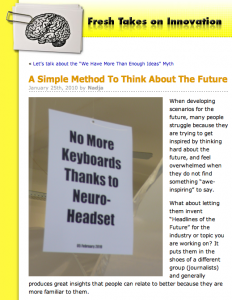I just read this brief blog post from BrainStore which is designed to help people visualise thinking about the future. They say to let them:
invent “Headlines of the Future” for the industry or topic you are working on? It puts them in the shoes of a different group (journalists) and generally produces great insights that people can relate to better because they are more familiar to them.
The example they give is:

This is a process that beings by eschewing assumptions. For example: lots of people have a concrete preconception of what makes a personal computer. They have severe difficulties in accepting notions which are outside of their paradigm. And it’s not just in computing. By challenging assumptions which are supposedly fundamental to the current stream of thought, we can find new ways to innovate.
Some of these (such as “No More Keyboards” are easy to envisage with the adoption of touch-screens and some of the brain-activity work going on in our local universities – keyboards could already be a thing of the past. But what about screens? We’ve seen a concept computer from DELL which doesn’t have a screen, it has a projector by default. Or how about a wearable computer which feeds data directly to a video headset. What about non-visible user interfaces like on the iPod shuffle? Or one which uses aural or haptic clues?
It isn’t quite as easy as just taking each statement and looking at the inverse – but rather to examine it for fragile assumptions.